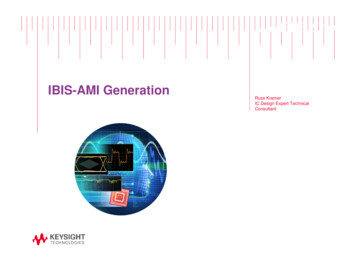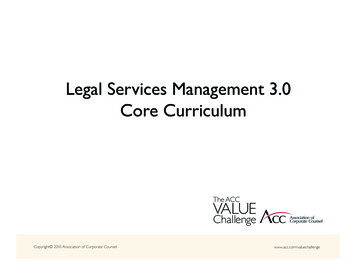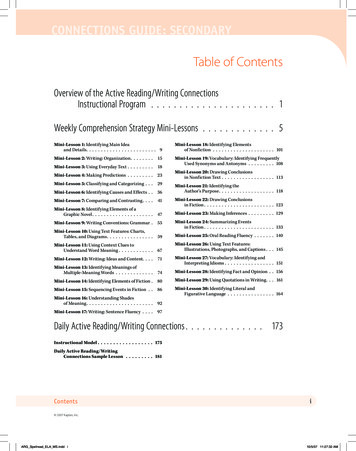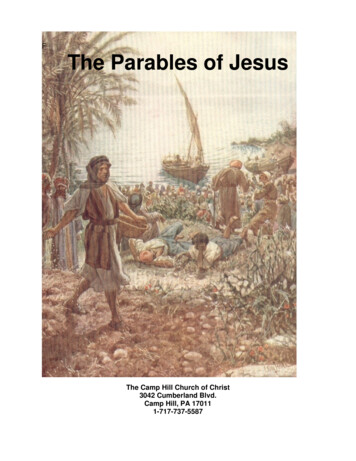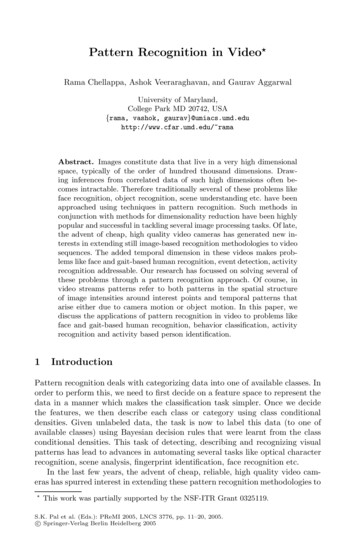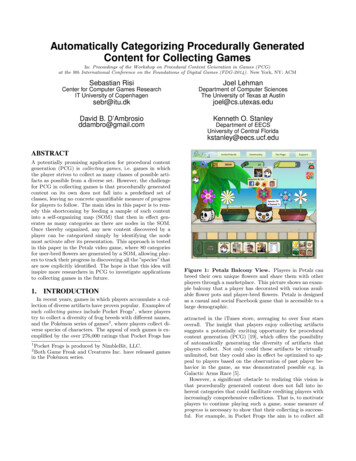
Transcription
Automatically Categorizing Procedurally GeneratedContent for Collecting GamesIn: Proceedings of the Workshop on Procedural Content Generation in Games (PCG)at the 9th International Conference on the Foundations of Digital Games (FDG-2014). New York, NY: ACMSebastian RisiJoel LehmanCenter for Computer Games ResearchIT University of CopenhagenDepartment of Computer SciencesThe University of Texas at Austinsebr@itu.dkjoel@cs.utexas.eduDavid B. D’Ambrosioddambro@gmail.comKenneth O. StanleyDepartment of EECSUniversity of Central Floridakstanley@eecs.ucf.eduABSTRACTA potentially promising application for procedural contentgeneration (PCG) is collecting games, i.e. games in whichthe player strives to collect as many classes of possible artifacts as possible from a diverse set. However, the challengefor PCG in collecting games is that procedurally generatedcontent on its own does not fall into a predefined set ofclasses, leaving no concrete quantifiable measure of progressfor players to follow. The main idea in this paper is to remedy this shortcoming by feeding a sample of such contentinto a self-organizing map (SOM) that then in effect generates as many categories as there are nodes in the SOM.Once thereby organized, any new content discovered by aplayer can be categorized simply by identifying the nodemost activate after its presentation. This approach is testedin this paper in the Petalz video game, where 80 categoriesfor user-bred flowers are generated by a SOM, allowing players to track their progress in discovering all the ”species” thatare now explicitly identified. The hope is that this idea willinspire more researchers in PCG to investigate applicationsto collecting games in the future.1.INTRODUCTIONIn recent years, games in which players accumulate a collection of diverse artifacts have proven popular. Examples ofsuch collecting games include Pocket Frogs1 , where playerstry to collect a diversity of frog breeds with different names,and the Pokémon series of games2 , where players collect diverse species of characters. The appeal of such games is exemplified by the over 276,000 ratings that Pocket Frogs has1Pocket Frogs is produced by NimbleBit, LLC.Both Game Freak and Creatures Inc. have released gamesin the Pokémon series.2Figure 1: Petalz Balcony View. Players in Petalz canbreed their own unique flowers and share them with otherplayers through a marketplace. This picture shows an example balcony that a player has decorated with various available flower pots and player-bred flowers. Petalz is designedas a casual and social Facebook game that is accessible to alarge demographic.attracted in the iTunes store, averaging to over four starsoverall. The insight that players enjoy collecting artifactssuggests a potentially exciting opportunity for proceduralcontent generation (PCG) [19], which offers the possibilityof automatically generating the diversity of artifacts thatplayers collect. Not only could these artifacts be virtuallyunlimited, but they could also in effect be optimized to appeal to players based on the observation of past player behavior in the game, as was demonstrated possible e.g. inGalactic Arms Race [5].However, a significant obstacle to realizing this vision isthat procedurally generated content does not fall into inherent categories that could facilitate crediting players withincreasingly comprehensive collections. That is, to motivateplayers to continue playing such a game, some measure ofprogress is necessary to show that their collecting is successful. For example, in Pocket Frogs the aim is to collect all
the different breeds of frogs. Therefore, to capitalize on thepotential for PCG to contribute to collecting games, suchcontent ideally would be categorized automatically by thegame itself.This paper presents a first such attempt to categorizeprocedurally generated content for the purpose of encouraging and rewarding players for collecting it. The proposedapproach is to feed a sample of such content into a selforganizing map (SOM) [8] that subsequently separates itinto as many nodes as are in the map. Once such a mapis thereby organized, any new content can be classified byidentifying the node in the map that responds most intenselyto its presentation. In this way, each node in the map becomes a category in the classification scheme, and players(who do not need to know that the underlying technologyis a SOM) can track how many such categories they havecollected, providing a sense of progress.This idea is demonstrated in this paper in the Petalz videogame [10] (Figure 1; available on Facebook and ), where players breed novel flowers that they exhibit on their own personal balcony. By feeding a sample of such flowers intoa SOM of predefined size, a set of categories is generatedthat helps to classify future flowers even though in principle the number of possible flowers is unlimited. In thisway, the SOM turns an open-ended space of content into aconcrete set of categories for collection, transforming Petalzinto a bona fide collecting game. Other PCG-driven collecting games in the future could also potentially benefit fromthis SOM-based approach.However, a major cost in designing games with a centralgoal of collection is that the artifacts to be collected are oftenindividually designed by humans to be visually appealing,distinguishable, or otherwise separate and unique. Theremust also be a large number of such artifacts, or players willtoo quickly exhaust the game’s content. This paper presentsan alternative approach, wherein the items to be collectedare created and categorized by the game itself, without direct human design.2.2Procedural Content GenerationThis section discusses games based on collecting, as wellas work on PCG in games, and the PCG algorithm in thePetalz game.PCG algorithms allow parts of the game (e.g. maps, textures, items, quests, etc.) to be generated algorithmicallyrather than by direct human design [6, 19]. This approachcan reduce design costs and also benefit players by presenting them with unique experiences each time they play.For example, the popular Diablo series6 generates dungeonswith PCG algorithms that players explore. Many PCG approaches rely on a fixed set of parameters or random numbergenerators, but recently focus has shifted towards applyingartificial intelligence approaches to enhancing PCG.Of particular note are evolutionary computation and othersearch-based approaches [19] that can further save on development costs and may be able to produce unique contentbeyond what human designers can create. One popular technique is interactive evolutionary computation (IEC [17]), inwhich the user guides evolution. One such example is NeuroEvolving Robotic Operatives (NERO [16]), in which players guide the evolution of a team of fighting robots. In another, Galatic Arms Race (GAR [4, 5]), weapons are evolvedautomatically based on user behavior. Other examples include Avery et al. [1], who evolved several aspects of a towerdefense game, Shaker et al. [13] who evolved levels for theplatform game Super Mario Bros, and Togelius and Schmidhuber [18], who experimented with evolving the rules of thegame itself.2.12.32.BACKGROUNDCollecting GamesVideo games nearly always feature some form of collection,from the coins and stars collected in Super Mario Brothers3to the weapons and achievements collected in modern firstperson shooters. However, a popular recent trend is to bringcollection to the forefront and make it the focus of the game.Pocket Frogs, in which the player’s goal is to collect andbreed as many different types of frogs as possible, is one suchgame. Pocket Frogs has been successful in part because ittaps into the natural human desire to find new items and setattainable goals [9]. Other popular games heavily integratethe idea of collecting, such as Rage of Bahamut4 and othervirtual collectible card games.Such games also incentivize social interaction among theirplayers, which can help them complete their respective collections. For example, games in the Pokémon series restrictthe distribution of creatures such that some creatures areonly found in certain versions of the game. Thus playersmust trade with others owning other Pokémon versions ifthey want to “catch ’em all,” as the game’s slogan suggests.This approach has been extended to online social games suchas Outernauts5 , which also presents players with a large array of monsters to collect, trade, and battle.3Copyright Nintendo, http://www.nintendo.comCopyright Mobage5Copyright Insomniac Games4The Petalz Video GameThe game discussed in this paper, Petalz [10], creates virtual flowers through a PCG algorithm. The central gamemechanic for players is to maintain and breed a collectionof unique flowers. All players possess a balcony (Figure 1),which they can decorate with various items and flower potsthat are purchased in the game’s market. This market is alsowhere flowers bred by other players can be bought and sold.Players can also interact by visiting each other’s balconiesand watering or liking the flowers there.New flowers are discovered through an IEC process inwhich players breed offspring by selecting a single flowerfor mutation (i.e. slight variation), or by mating two flowersthrough cross-pollination. Figure 2 shows an example of theresults of such mating.2.3.1Generating Flower Images and ShapesThis section provides context by explaining the encoding behind the flowers in Petalz. However, it is importantto note that the idea for classifying procedurally generatedcontent through a SOM in this paper in principle is independent of the specific encoding.Flowers in Petalz are encoded by a special kind of compositional pattern producing network (CPPN [14]). CPPNsare a variation of artificial neural networks (ANNs) that6Copyright Blizzard Entertainment, http://blizzard.com/
L .5rFigure 2: Flower Cross-pollination. By mating twoflowers, children that exhibit the traits of both parents canbe created. This approach gives players a powerful and intuitive means to explore the space of flowers.differ in their set of activation functions and how they areapplied [14]. While ANNs often contain only sigmoid orGaussian activation functions, CPPNs can include both suchfunctions and many others. The choice of CPPN functionscan be biased toward specific patterns or regularities. Additionally, unlike typical ANNs, CPPNs are usually appliedacross a broad space of possible inputs so that they canrepresent a complete image or pattern. Because they arecompositions of functions, CPPNs in effect encode patternsat infinite resolution and can be sampled at whatever resolution is desired. Other successful CPPN-based applicationsinclude Picbreeder [12], MaestroGenesis [7], EndlessForms[3], the Galactic Arms Race (GAR) video game [4], foldedwire robots [11], and virtual soft-body robots [2].The general idea behind the flower encoding in Petalz isto deform a circle such that the resulting shape resembles aflower. Because this approach focuses on a radial pattern,polar coordinates {θ, r} are input into the CPPN (Figure 3).For each value of θ, the deformed radius of the circle at thatpoint (rmax ) is queried by inputting {θ, 0} into the CPPN.Next, to fill in the colors of the flower’s surface, each polar coordinate between 0 and rmax is queried with the sameCPPN for a RGB color value. This approach produces a deformed, colored circle, but still may not produce flower-likeimages. Most natural flowers demonstrate basic radial symmetry in the form of their petals; this property is exploitedin the encoding by inputting sin(P θ) into the CPPN instead of the raw θ value, which creates a repeating patternof deformation and coloration. The optional P parameterallows control over the period of the sine function and thusthe maximum number of repetitions around the circle.Finally, to further improve the aesthetic of the flowers, theconcept of layers is implemented to reflect that flowers generally have internal and external portions. To encode thisproperty, a new flower is queried through the same CPPNfor each layer L. Each such layer is scaled based on its depthand drawn on top of the previous layer. Thus the inputs tothe CPPN are {θ, 0, L} and the outputs are {R, G, B, rmax }to determine the shape of each layer (Figure 3). The internal coloring is then determined by querying the CPPN aswith the outermost layer. Interestingly, because the layersare queried by the same CPPN, they are mathematically related, giving a natural look. Further optimizations on thisgeneral algorithm are employed [10] to achieve the fast rendering necessary for an online game.The flower-encoding CPPNs in Petalz are evolved withthe NEAT algorithm [15]. NEAT begins with a populationof simple neural networks or CPPNs and then adds complexity over generations by adding new nodes and connectionsthrough mutations. By evolving networks in this way, thetopology of the network does not need to be known a priori;NEAT searches through increasingly complex networks toL 1.0Figure 3: CPPN Flower Encoding. The CPPN thatencodes flowers in Petalz takes polar coordinates (r and θ)as well as layer (L) and bias (b) values. The outputs arean RGB color value for that coordinate. The value rmaxis also output, but only checked when r 0 to determinethe maximum radius for a given θ. The number and topology of hidden nodes is evolved by a standard CPPN-NEATimplementation [14].find a suitable level of complexity. For a complete overviewof NEAT see Stanley and Miikkulainen [15]. Most importantly, such complexification, which resembles how genes areadded over the course of natural evolution, allows NEAT toestablish high-level features early in evolution and then laterelaborate on them. For evolving content, complexificationmeans that content (e.g. flowers in the case of Petalz) canbecome more elaborate and intricate over generations.3.AUGMENTING PCG GAMES WITHCOLLECTION MECHANICSWhile collection game mechanics have worked well in engaging players in a variety of different games like PocketFrogs or the Pokémon series, how PCG-based games canbe augmented which such mechanics is an open researchquestion. Although PCG approaches can benefit players bypresenting them with unique experiences and content eachtime they play, in PCG games like Petalz [10] or GAR [4],there are no a priori categories of flowers or weapons for theplayer to collect.Furthermore, though some players thrive in such free-formgames without explicit goals, many other players enjoy goaldirected game mechanics where concrete purpose is directlyprovided (e.g. collect all 80 flower species, collect ten flowersof a specific species). Therefore a promising idea is to automatically organize the procedurally generated content intospecific categories, thereby providing a means to augmentany PCG game with collection mechanics.To automatically organize procedurally generated contentrequires a classifier that can automatically determine thecategory of newly generated content based on a training setof data. Importantly, this classification has to be meaningful to the player. For example, if the algorithm assigned thesame class to two very differently looking flowers, the collection mechanic would not add meaning and structure to theplayer experience.In this paper the procedurally generated content is classified based on the self-organizing map (SOM) algorithm [8].While many other clustering algorithms could be applied,the SOM algorithm offers some unique advantages that give
it particular appeal in a game context, which will be explained in the next section.3.1Self-Organizing MapThe SOM [8] is an artificial neural network that performsan unsupervised mapping from a high-dimensional inputspace RD with input input patterns X {xi : i 1, ., D}onto a two-dimensional grid of neurons. Each neuron j inthe computation layer is connected to each input neuron iwith weight vector wj {wij : i 1, ., D}.The basic training process works by iteratively presentingan input vector x to the SOM and then comparing the weightvectors of the neurons on the grid to that input vector. Theneuron c with the most similar weight vector is called thebest matching unit (BMU) and is defined by the condition: x(t) wc (t) x(t) wi (t) i.(1)Once the BMU is determined, its weights and the weightsof all the neurons within a fixed distance to the BMU areupdated:wi (t 1) wi (t) hc(x),i (x(t) wi (t)),(2)where t is the index of the training step and h is calledthe neighborhood function, which is commonly a Gaussianfunction:hc(x),i α(t)e ri rc 22σ 2 (t),(3)where 0 α(t) 1 is the learning-rate, which decreasesmonotonically with the training step t. In addition, ri andrc are the locations on the SOM map and σ(t) correspondsto the width of the neighborhood function. The width of theneighborhood function also decreases monotonically withthe training steps.The SOM can help with classification [8, 20] by assigninga class to each neuron and determining the class of a newsample based on the class of its BMU. In other words, byfeeding a sample of procedurally generated content into aSOM of predefined size, a set of categories is generated thathelps to classify future content even though in principle thenumber of possible content is unlimited. Figure 4 gives anoverview of this approach to categorizing procedurally generated content.Two properties of the SOM give it particular appeal incategorizing procedurally generated content for the purposeof encouraging players to collect it. First, after training, theSOM forms a topographic map of the input space, in whichcontent that is visually similar is also nearby in space. Inthis way the SOM can provide an intuitive visualization ofthe space of content for the player. Second, the prototypeweight vectors of the neurons on the grid can be visualizedto give the player an idea of categories not yet discovered.The next section describes how the SOM algorithm is applied to automatically categorize flowers into different speciesin the Petalz video game.4.EXPERIMENTIn this paper the automatic categorization of procedurallygenerated content is tested in the Petalz video game [10]. Forthis purpose the game is augmented with a SOM-based collection game mechanic that allows the player to track theirprogress in discovering all pre-classified flower categories.Figure 4: PCG Collection Game Mechanic. The SOMis first trained with samples of procedurally generated content (a). Once the SOM is fully trained, new content discovered by the player can automatically be categorized (b).Tracking the collection progress (c) can then add meaningand structure to the player experience.To classify different flowers with a SOM the question ofhow to best represent these flowers for training becomes important. Two different methods for presenting flowers tothe SOM are tested to determine which produces the mostmeaningful flower categories. The SOMs for all approacheshave the same size of 5 16 neurons, resulting in 80 different categories for user-bred flowers. Each SOM is trainedwith a selection of 2,000 diverse flowers that were evolvedby players during the game.In the phenotypic clustering approach the images ofthe training flower are scaled from 200 200 pixels to a50 50 pixel black-and-white version. Because the procedurally generated flowers in Petalz are all symmetric along thex and y axis it is only necessary to feed the top-left square(25 25 pixels) into the SOM for training and also classification during the game. Therefore each flower is describedby a feature vector of 625 integers.In the genotypic clustering approach each flower is described by its pair-wise genotypic distance to the 2,000 otherflowers in the training set. Following Stanley and Miikkulainen [15] the distance δ between two CPPN encodings canbe measured as a linear combination of the number of excess (E) and disjoint (D) genes, as well as the average weightdifferences of matching genes (W ): δ E D W .5.RESULTSFigure 5 shows examples of the phenotypic clustering bythe SOM. The flowers belonging to the same species show aclear resemblance to one another, suggesting that the SOMcan produce a meaningful clustering of the procedurally generated flowers.
Figure 5: Phenotypic Flower Clustering. The picture depicts the 80 distinct species in Petalz. Examples of flowersclustered into three different species are depicted to the right. The main result is that the phenotypic clustering of flowers ismeaningful and thus demonstrates the feasibility of augmenting PCG games with a collection game mechanic. Note that theSOM is toroidal, which means that the flower prototypes to the far right of the flower chart (left panel) are also borderingthe prototype vectors to the far left. The same holds true for the flowers at the bottom and the top of the flower chart.Every time the player discovers a new species, a flowerchart is displayed (Figure 5, left) and the newly bred floweris highlighted. In addition to the discovered flowers, the prototype vectors of the remaining flower species are also shown.That way, the flower chart gives the player direct feedbackabout his progress in the game and about flower categoriesthat are still undiscovered. Note that the 80 displayed flowercategories reflect the topology of the SOM (16 5 neurons).Additionally, because the SOM produces a topographicmap of the training data, flowers that are phenotypicallymore similar than other flowers are also grouped closer together in space. As Figure 5 (left) shows, the result is avisually appealing smooth gradient of different flower prototype weights.The genotypic clustering (based on the genotypic distancesbetween the flowers) is shown in Figure 6. While some classifications are satisfying (e.g. Species 1 ), some flowers thatdo not show a clear phenotypic resemblance also group together (e.g. Species 25, Species 69 ). These inconsistencies inthe clustering happen because small changes in the flower’sgenotype can sometimes produce more significant changesin the decoded phenotypes.The main result is that procedurally generated contentcan automatically be clustered into different categories (likeflower species), thereby adding more meaning and structureto player experience. Additionally, this paper showed that– at least in Petalz – a clustering based on phenotypic characteristics produces more intuitive classifications than onesolely based on genotypic distances.6.DISCUSSION AND FUTURE WORKThe results represent a proof of concept for a generalmethod to augment PCG games with a collection game mechanic. Importantly, such a game mechanic can add meaning and structure to a game player’s experience, which otherwise might be missing when PCG is the game’s centralfocus. That is, while user exploration of PCG can providethe potential for unlimited novelty in game content, it stillmay not inherently provide explicit purpose to motivate auser’s search. For example, without the objective of collect-Figure 6: Genotypic Flower Clustering. This figureshows a SOM clustering of the flowers based on their pairwise genotypic distances. While such genotypic clusteringsometimes produces meaningful clusters (e.g. Species 1 ), often flowers are grouped together that look significantly different (e.g. Species 25, Species 69 ).ing a flower from all 80 SOM-determined species in Petalz, auser has little purpose beyond indulging their own aestheticpreferences when breeding flowers. Although the success ofopen world games demonstrates that not all players requireexplicit goals, many players do enjoy the concrete purposethey provide. Thus the clear benefit for extending PCGgames with a collection game mechanic is the potential forbroader appeal, by providing enjoyable opportunities bothfor self-directed and goal-directed players.An interesting side-effect of the collection game dynamicis that it grants inherent value to evolved artifacts in speciesthat are hard to discover. Players may not only feel a senseof accomplishment in discovering a new species, but mayassign greater personal value to such flowers themselves because they were hard to find. If players feel proud or connected to the content they create, an interesting possibilityis that they may desire for such evolved content to be visible outside the context of a computer game. For example,three-dimensional printouts of a player’s collected content
categories as there are nodes in the SOM. That way, even ifthe space of content is effectively unlimited, players can stillexperience a sense of quantifiable progress as they discoveran increasing proportion of the SOM-based category space.This approach was tested in the Petalz video game, where aSOM computed 80 categories (called ”species” in Petalz) forplayers to discover. The main conclusion is that PCG canbe adapted to support collecting games when complementedwith an effective method for content categorization.References[1] P. Avery, J. Togelius, E. Alistar, and R. van Leeuwen.Computational intelligence and tower defence games.In Evolutionary Computation (CEC), 2011 IEEECongress on, pages 1084–1091. IEEE, 2011.[2] N. Cheney, R. MacCurdy, J. Clune, and H. Lipson. Unshackling evolution: evolving soft robots with multiple materials and a powerful generative encoding. InProceedings of the Genetic and Evolutionary Computation Conference (GECCO-2013), New York, NY, 2013.ACM Press.Figure 7: Printed Artificially-Evolved Flower. Thisexample is a flower that was evolved by users in Petalz,manually converted into a three-dimensional representation,and then printed in three dimensions.[3] J. Clune and H. Lipson. Evolving 3d objects with agenerative encoding inspired by developmental biology.In Proceedings of the European Conference on ArtificialLife (Alife-2011), volume 5, pages 2–12, New York, NY,USA, Nov. 2011. ACM.can potentially bring evolved game content to the real world(figure 7 shows an example printed from Petalz).Finally, automatically clustering procedurally generatedcontent may open up applications beyond the singular collection game mechanic presented in this paper. For example,many video games segment levels into higher-level groupsthat are often called worlds.Typically, the levels in each world share a common theme,thereby providing a coherent experience for users as theyprogress through the game. For instance, in Super MarioBrothers 37 , world four (“Big Island”) features levels withoversize enemies and terrain elements, while levels in worldseven (”Pipe Maze”) are largely composed of networks ofpipes. However, a game based on procedurally-generatedlevels may lack this sense of coherence unless such levelsare organized in a noticeably structured way. Clusteringprocedurally-generated levels may provide a means for suchorganization, and may facilitate automatically generatingworlds with a coherent theme. More broadly, clustering content provides a mechanism for automatic categorization ofevolved artifacts, which can potentially be exploited in otherways beyond theming or collection.An interesting direction for future work is to explore thegenerality of the automatic collection game mechanic by applying it to other games centered on PCG like Galactic ArmsRace video game [5].[4] E. Hastings, R. Guha, and K. O. Stanley. Evolvingcontent in the galactic arms race video game. In Proceedings of the IEEE Symposium on Computational Intelligence and Games (CIG-09), Piscataway, NJ, 2009.IEEE Press.7.CONCLUSIONThis paper proposed an approach to incorporating PCGeffectively into collecting games. While procedurally generated content on its own does not automatically fit intopredefined categories, the proposed approach is to feed thecontent into a SOM that is trained to classify it into as many7Copyright Nintendo, http://www.nintendo.com[5] E. J. Hastings, R. K. Guha, and K. O. Stanley. Automatic content generation in the galactic arms racevideo game. IEEE Transactions on Computational Intelligence and AI in Games, 1(4):245–263, 2009.[6] M. Hendrikx, S. Meijer, J. Van Der Velden, and A. Iosup. Procedural content generation for games: Asurvey. ACM Transactions on Multimedia Computing, Communications, and Applications (TOMCCAP),9(1):1, 2013.[7] A. K. Hoover, P. A. Szerlip, and K. O. Stanley. Generating a complete multipart musical composition froma single monophonic melody with functional scaffolding. In M. L. Maher, K. Hammond, A. Pease, R. P. Y.Perez, D. Ventura, and G. Wiggins, editors, Proceedingsof the 3rd International Conference on ComputationalCreativity (ICCC-2012), 2012.[8] T. Kohonen. Self-organizing maps, volume 30. Springer,2001.[9] W. D. McIntosh and B. Schmeichel. Collectors andcollecting: a social psychological perspective. LeisureSciences, 26(1):85–97, 2004.[10] S. Risi, J. Lehman, D. B. D’Ambrosio, R. Hall, andK. O. Stanley. Combining search-based procedural content generation and social gaming in the petalz videogame. In Proceedings of the Artificial Intelligence andInteractive Digital Entertainment Conference (AIIDE2012), Menlo Park, CA, 2012. AAAI Press.
[11] S. Risi, D. Cellucci, and H. Lipson. Ribosomal robots:Evolved designs inspired by protein folding. In Proceedings of the Genetic and Evolutionary Computation Conference (GECCO-2013), New York, NY, 2013.ACM.[12] J. Secretan, N. Beato, D. D’Ambrosio, A. Rodriguez,A. Campbell, J. Folsom-Kovarik, and K. Stanley.Picbreeder: A case study in collaborative evolutionaryexploration of design space. Evolutionary Computation,19(3):373–403, 2011.[13] N. Shaker, G. N. Yannakakis, J. Togelius, M. Nicolau,and M. O’Neill. Evolving personalized content for super mario bros using grammatical evolution. In Proceedings of the Artificial Intelligence and Interactive DigitalEntertainment Conference (AIIDE 2012), Menlo Park,CA, 2012. AAAI Press.[14] K. O. Stanley. Compositional pattern producing networks: A novel ab
Content for Collecting Games In: Proceedings of the Workshop on Procedural Content Generation in Games (PCG) at the 9th International Conference on the Foundations of Digital Games (FDG-2014). New York, NY: ACM Sebastian Risi Center for Computer Games Research IT University of Copenhagen sebr@itu.dk Joe





